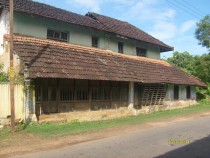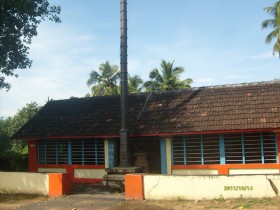Perinkulam, my ancestral village
The 2 nd and concluding part
There was a big rock formation on the main road of the South village, which was removed and the road leveled, by Sri. Doriappan mama who also took lead in the construction of a Mantapam for the Krishnaswamy, where the marriage of my first sister took place over five decades ago. He had a small elephant, Krishnankutty, fondled by the villagers. The temple chariots started rolling through the main street of Thekkae gramam only after the blockade was removed.
Water scarcity was a major problem and I have seen womenfolk carrying water, all the way from the well adjoining Perinkulam. Most of the occupants were priests with a meager income but lead a satisfied life as their needs were minimum. They were seen moving with barren chest across the streets, some with a thorthumundu, a small piece of cloth on their shoulders. They never wore their footwear inside the village. I had seen my father removing his footwear and holding those in his hands, while entering the village, during his visits. He lived at Olavakkode, but used to frequently visit the village. There was a small elementary school and students went to Alathur for high school studies. There was a bank in the Thekkae gramam and another one in the Bank Road. Brahma sri Krishna VadhyAr, his son Kailasa VadhyAr , Ramu VadhyAr, Konthai VadhyAr and Tiruvilwamalai Ramaswamy VadhyAr were known to me personally, in the Thekkae gramam, to which my father belonged to. I also knew Vicha VadhyAr of the Padinjare gramam.
Sri. P. G. Gopalakrishna Iyer, the head master of the NES High school, Alathur and Vakil Viswanatha iyer were my father’s cousins.
I have heard about Sri. Raghava Sastrigal, a famous Vaidik and astrologer and have met another prominent astrologer Mookkunni Thirumulpad, who wrote my horoscope and also Shiromani( forgot his name though related to me ) . The benevolent Chamikutty Nair was liberal in supplying provisions from his shop on credit, to the cash-starved Brahmins and never troubled the defaulters! I know him too.
I am told that his shop is not there now, but opposite to it, blooms red lotuses in an abandoned pond!
Many of our villagers used to visit us, on their way to receive or see off their relatives at the Railway station, which was close to our house. My father was known as Olavakkode Ananthan and his nickname in the village was KariakkAr. Villagers were experts in giving nicknames, appropriate and funny. None knows me in my village by my furlong- long passport name!
We have a vacant land adjoining the temple, sanctified as the parking place for the Ratham, chariot of our Krishnaswamy. My knowledge of the Agraharam is limited as I didn’t live there, though the very name, sends emotive vibrations through my nerves. Whenever I enter my village, I bow my head down in reverence to the air and soil with which is mingled the memories of my forebears. Their worldly remains were charred to ashes on the bank of Chooriappan kulam and I used to spend some silent minutes musing on the pleasures and pangs of their lives about which I have heard stories from my father. My blog contains a few writes up on my ancestral village. I was excited when my youngest son Srikanth and his wife, married just a few days before, took active part in the car festival, during our last visit. The satisfaction that our children carry on our ancestral torches of culture is unique. The neipandams, (hand torches soaked in ghee and ignited ) the grand kids carry, when a dead body is removed from the house, symbolizes their carrying forward our tradition?
The shape and occupancy of the Brahmin Agraharams are changing fast and in due course, the tile roofed, top -slopping houses in two rows will be replaced with monotonous flats albeit with better comforts .The charm of thinnais, the raised platforms with polished floors in the front, which used to serve as our drawing room, visitors lounge, game center, individual and group meeting platforms etc will be lost for ever. The present generation and perhaps the next might fonder the memory of Thinnai, koodam, kottukoodam, chAipu, matchu, arai etc ( various portions of the house) for some more years and afterwords, like all other old objects, those too will get submerged under the waves of the Past. I will miss the top -opened Nadumuttams , in the heart of the houses, the big receptacle of sun light and rain.
There are stories of miracles about the village deities but I would not like to dwell on that topic. I have, however to mention two happenings of personal experience.
My younger brother, Viswanathan, as a child, had an aversion for cooked rice; he used to abhor the very sight of it . My father, once arranged for PAyasa neivedyam with rice and distributed the prasadam to children in the mantapam before the shrine. Vicha, on his own, came and sat along with other kids and tasted the neivedyam served on a plantain leaf. From then on, he had no problem in consuming cooked rice. He started eating much more than me! Now, both of us don’t go near the rice food, for a different reason!
Another event I observed was, a Garuda bird used to appear in the sky and circumambulate the chariot at the time of Ratharohanam.
In the olden days, our elders never used to wear shirts or sandals while pulling the chariots. It was a regular practice to prostrate before the chariot, at the time of installation and demounting the idols from the chariot. Before each house, women used to wait with lamps, fruits and flowers to receive the God in his chariot. The Jagannathan, the supreme Lord of the Universe, comes to our door front, in all his glory!!
. Sambaram, further liquified butter milk or coconut water used to be served, free of cost, at many places. Many are still following these practices. The elders used to distribute small coins, called, ‘ther kaineetam’ to children and servants. Clothes too used to be donated by those who could afford. I remember having received a four anna coin from my Sivaswamy Chithappa as ther kaineetam, while I stayed in his house during a holiday. His mother, my Venku Chithammai patty has gained a seat in my stories for her ‘PahavAnae Saranam’ phrase. That was her equivalent for ‘do they duty, that is best; leave unto thy God, the rest’ .When things go beyond my control, I too repeat her oft- used phrase. Incidentally, the villagers were never short of wits and humor and conversation skill, though were short of money.
My father was an expert conversationalist with wits and wisdom. None of his children, inherited his qualities of maturity, courage and will power, though he was a school- dropout. His personal charm too. His walk, from his village to Palakkad, with my mother and me as a baby on his shoulder, for starting a small business, despite his traditional background , was the beginning of our migration, which, has landed now his progeny ,in countries beyond seas. In every family, there will be one person, who starts the first walk.
I envy the villagers’ cool – headed approach to problems and courage to face calamities, Awesome was their attitude of taking life and events, ‘as they unfolded’.
My ‘NamAmi nithyam Navaneetha Krishnam ‘ stotram is a humble Tulasidalam, dedicated at the lotus feet of our Krishnaswamy.
We have left Perinkulam , seeking food and shelter elsewhere. But, our village will never leave us. Go to any remote corner of the Globe, you will see one or two Perinkulams.
Perinkulam lives!


Hello mama. Thank you so much for such a lovely write up. My father’s side is also Perinkulam. My great grandfather was fondly called as Ochapatta. He was from thekke gramam. I have heard he event built a kolam. His name was dorai / bhaskar. I am not sure whether you have information in him.
Enjoyed reading it very much 😊.
Dear Sir, you forgot to mention a great person who brought water and electricity to the village Sri Anantha narayana iyer Retd Teacher.also